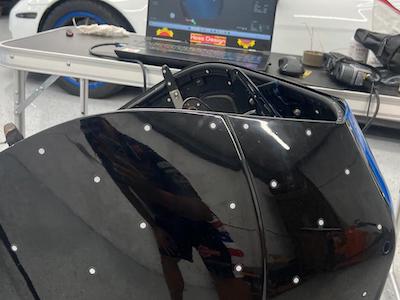What is 3D Scanning Technology?
3D scanning is a technology that captures the physical characteristics of an object or environment and converts them into digital models. These scans provide precise measurements, which can be used to recreate a digital version of the scanned object. Various types of 3D scanning technologies exist, including laser scanning, structured light scanning, and photogrammetry, each suitable for different applications.
Laser scanning, for example, uses laser beams to measure distances between the scanner and the object’s surface, capturing highly detailed information. Structured light scanning projects patterns onto an object, and the distortion of these patterns is used to calculate depth and shape. Photogrammetry uses photographs taken from different angles to generate 3D models. All of these methods result in highly accurate digital representations of real-world objects, which are essential in industries like automotive, aerospace, and consumer goods.
Role of 3D Scanning in Conceptual Design
One of the most significant benefits of 3D scanning in modern product development lies in its ability to accelerate the conceptual design phase. Traditionally, designers relied on manual measurements, sketches, and CAD modeling, which could take days or even weeks. With 3D scanning, this process is shortened to mere hours. Designers can quickly capture real-world objects and incorporate them into their design workflow.
For instance, when designing a new automotive part, a 3D scan of an existing vehicle component can be used as the foundation. Designers can then modify and improve upon the scanned model with CAD software, creating new iterations without starting from scratch. This level of precision and speed enhances creativity, allowing designers to experiment more freely with various concepts. Additionally, 3D scans help assess the feasibility of new designs, ensuring that they can be manufactured effectively before moving further in the development process.
Prototyping with 3D Scanning
Once the initial concept is developed, the next crucial stage in product development is prototyping. Prototyping helps transform digital models into physical products, allowing for real-world testing and evaluation. 3D scanning plays a vital role here by streamlining the prototyping process.
In traditional methods, prototyping involves a lot of trial and error, often requiring several iterations to perfect the design. However, with 3D scanning, the accuracy of the digital model minimizes errors, reducing the number of iterations needed. Designers can scan early prototypes and compare them with the original digital model, identifying any discrepancies or necessary adjustments quickly. This ensures that subsequent prototypes are closer to the final product, saving time and reducing costs.
Moreover, 3D scanning enables reverse engineering. If a company has an older product or a part that needs improvements or replacements but lacks the original design files, 3D scanning can digitize the existing object. Engineers can then use the scanned data to redesign the part, ensuring a perfect fit with modern requirements.
3D Scanning for Manufacturing Optimization
As the product moves from prototyping to manufacturing, 3D scanning continues to provide significant advantages. One of the biggest challenges in manufacturing is ensuring that the product design is optimized for mass production—commonly referred to as Design for Manufacturability (DFM). Here, 3D scans play a key role in verifying that the design can be efficiently and cost-effectively produced.
With 3D scanning services near me, manufacturers can capture high-resolution models of tooling, molds, or even parts of the production line itself. This allows them to simulate the manufacturing process, identifying potential issues before production begins. For instance, a scan of a mold can be analyzed to ensure that it matches the digital design perfectly, eliminating costly defects or misalignments. This process minimizes the risk of production delays, helps maintain quality control, and reduces waste, ensuring that the product can be manufactured at scale without compromising on precision.
Furthermore, 3D scanning aids in quality assurance. During the production phase, scans of the manufactured parts can be compared to the original digital design. Any deviations can be quickly identified and rectified, ensuring consistency and maintaining the high-quality standards set during the design process. This level of control is especially crucial in industries like aerospace and healthcare, where precision is non-negotiable.
The Future of Product Development with 3D Scanning
The use of 3D scanning in modern product and prototype development near me is just the beginning of a broader technological evolution. As scanning technologies continue to improve, with faster data capture, greater accuracy, and enhanced portability, their application across various industries will only expand. Already, 3D scanning is becoming a vital tool not only in product design but also in fields like archaeology, medical imaging, and architecture.
Media Contact
Company Name: Hoss Design USA LLC
Email: Send Email
Country: United States
Website: https://hossdesignusa.com

